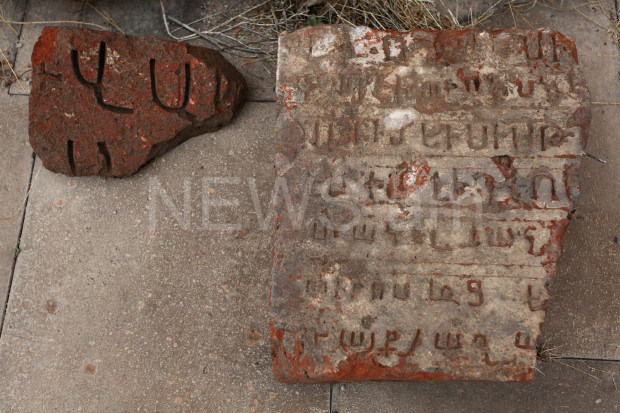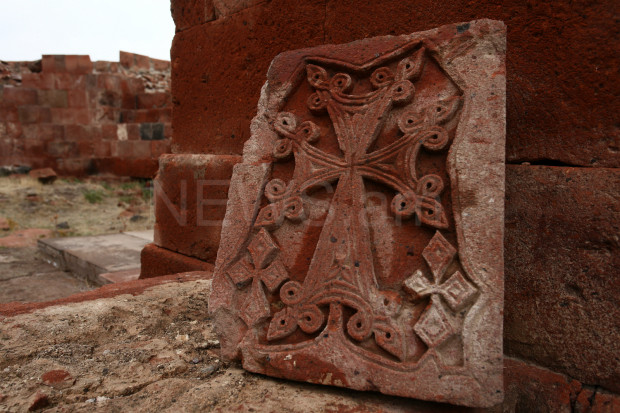The story of Dashtadem fortress is full of mysteries and surprises. The fortress, which is one of the most preserved ones in the country, is located to the south of a village of the same name in Aragatsotn province. It is quite popular with foreigners, for instance, the French.
The first thing striking one’s eye on entering the fortress complex is the private houses. The direct neighborhood with the medieval monuments seems not to discompose only its residents, who firmly decided to settle in its territory in the Soviet period.
In 2006, the Government allocated money for the reconstruction of the fortress and cleaning the site from unwanted constructions. Part of the work was indeed somehow carried out: the main entrance to the fortress and the church in its territory were reconstructed. Apart from this, the residents of the houses relocated to other settlements built for them. The archaeologists took a breather but certain constructions still remain.
Dashtadem fortress (translated in Armenian as “in front of the field”) used to be an important fortification, which protected the eastern routes of approach to the city of Ani. It was founded in the 10th century during Bagratuni dynasty. The fortress was originally a construction covered with logs and based on a rectangular plan, archaeologist Astghik Babajanyan says.
In the 12th century, the last ruler of Ani from Shadadd dynasty, Sultan ibn Mahmud ibn Shavuri, added polygon and semicircular towers to it. The inscription in Arabic carved on one of the towers tells about this construction.
Later, after Armenia overthrew the Seljuq yoke, the fortress passed into the ownership of the princely family of Zakaryans. In the 12-13th centuries, princes launched large-scale construction work: the internal rampart with semicircular towers, whose ruins have been preserved up to now, was erected. The one-body church built form red tufa also dates back to the period of Zakarians’ rule.
The 14th century inscription in Armenian by the western entrance to the fortress is also remarkable. Made by Aghbughe, son of Ivane Zakaryan, it tells about certain festivity in honor of exempting Talin from wine tax. According to the archaeologist, the fortress was seriously damaged during the Mongol-Tatar invasion. Traces of fire can still be noticed on the second floor of the monument. No documentation has yet been found on the life of the fortress in the 15-18th centuries but archaeologists assure that the found artifacts allow to conclude that it had then lost its original strategic significance, turning into an ordinary village settlement.
In 1812, Erivan serdar (ruler) Huseyn Khan carried out reconstruction work and initiated the construction of a second row of rampart from coarse ragstone and with eight towers in the corners.
The excavations in the fortress were carried out in different years. The first archaeologist to study the medieval monuments in 1989 was Yesayi Asatryan. The following research work was carried out in 2005-2006. In 2011-2012, a French expedition worked in Dashtadem. The last excavations were carried out in 2015.
Thus, it was revealed that the fortress is based on a cliff. The marks of master masons, including the remarkable inscription of a mason Hovhannes (13th century), have been preserved on certain stones.
The archaeologists found out an underpass covered with stones and a huge 15-16 cubic meter square, whose application is not yet known, as well as an enormous reservoir for water dug in a tufa monolith. There is no natural spring nearby, therefore water was collected and apparently used sparingly. The sizes of the reservoir are yet unknown, since it has not been cleaned till the end.
Among archaeological finds pottery and stone artifacts of labor prevail. Different cross-stones (khachkars), fragments of tombstones, bronze cups, sword-blades, gun projectiles and glass items, in particular bracelets have also been found.
One of the most curious artifacts is the copper coin, which turned out to be a 12th-century Seljuk fels.
Despite the interest towards the fortress, lots of things still remain unclear, the archaeologist notes. The archaeologists still have to dispel myths on the history of the fortress. There is no single opinion on the intended purpose of certain constructions either. Therefore, it is necessary to continue the excavations, engaging modern technology and specialists, Babajanyan concluded.



































